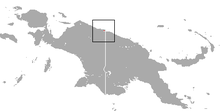- Sir David's long-beaked echidna
-
Sir David's long-beaked echidna[1] Conservation status Scientific classification Kingdom: Animalia Phylum: Chordata Class: Mammalia Order: Monotremata Family: Tachyglossidae Genus: Zaglossus Species: Z. attenboroughi Binomial name Zaglossus attenboroughi
Flannery & Groves, 1998
Sir David's long-beaked echidna range Sir David's long-beaked echidna (Zaglossus attenboroughi), also known as Attenborough's long-beaked echidna or the Cyclops long-beaked echidna, is one of three species from the genus Zaglossus to occur in New Guinea. It is named in honour of Sir David Attenborough, the eminent naturalist. It lives in the Cyclops Mountains in Papua province of Indonesia near the cities of Sentani and Jayapura.
It is the smallest member of the genus, being closer in size to the short-beaked echidna than are other members of the genus. The male is larger than the female, and can be differentiated by the spurs on its hind legs. The echidna is not a social animal, and comes together with its own kind only once a year, in July, to mate. The female will lay the eggs after about eight days, and the babies will stay in the mother's pouch for around eight weeks or until their spines develop.
The creature is nocturnal, and can roll up into a spiny ball when it feels threatened, somewhat in the manner of a hedgehog. The echidna weighs from 5 to 10 kilograms (11 to 22 lb), and is found all over New Guinea, although it is most common in the mountain ranges.[3]
The echidna is endangered by hunting and habitat loss. In fact, in the 1900s, it was thought to be extinct until some of their "nose pokes" were found in the mountains of New Guinea. These "nose pokes" are very distinct and represent the echidna's feeding techniques.[4] The diet of this hardy-built animal consists of earthworms, termites, insect larvae and ants.
The species was described from a single damaged specimen collected in the Dutch colonial era (c. 1961), and has apparently not been collected since then.[5] Given the ongoing anthropogenic disturbance of the Cyclops Mountain forest habitat, this has raised concern that Z. attenboroughi populations may already be endangered or even locally extirpated. However, biological surveys of Papua province are notoriously incomplete; it is possible the animal still exists there or in related mountain ranges.
This animal is so high in the endangered-species list that locals are being educated on this creature and asked to stop their tradition of hunting and killing it and sharing it with rivals as a peace offering.[6]
As reported on July 15, 2007, researchers from EDGE visiting Papua's Cyclops Mountains had recently discovered burrows and tracks thought to be those of Zaglossus attenboroughi. Furthermore, communication with local people revealed the species had perhaps been seen as recently as 2005.[7]
Sir David's long-beaked echidna was identified as one of the top-10 "focal species" in 2007 by the Evolutionarily Distinct and Globally Endangered (EDGE) project.[8]
References
- ^ Groves, Colin P. (16 November 2005). "Order Monotremata (pp. 1-2)". In Wilson, Don E., and Reeder, DeeAnn M., eds. Mammal Species of the World: A Taxonomic and Geographic Reference (3rd ed.). Baltimore: Johns Hopkins University Press, 2 vols. (2142 pp.). p. 1. ISBN 978-0-8018-8221-0. OCLC 62265494. http://www.bucknell.edu/msw3/browse.asp?id=10300011.
- ^ Leary, T., Seri, L., Flannery, T., Wright, D., Hamilton, S., Helgen, K., Singadan, R., Menzies, J., Allison, A., James, R., Aplin, K., Salas, L. & Dickman, C. (2008). Zaglossus attenboroughi. In: IUCN 2008. IUCN Red List of Threatened Species. Downloaded on 28 December 2008. Database entry includes justification for why this species is listed as critically endangered.
- ^ "New hope over 'extinct' echidna". BBC News. 2007-07-15. http://news.bbc.co.uk/2/hi/science/nature/6897977.stm. Retrieved 2010-05-23.
- ^ http://www.edgeofexistence.org/mammals/species_info.php?id=2
- ^ Flannery, T.F.; C.P. Groves (1998). "A revision of the genus Zaglossus (Monotremata, Tachyglossidae), with description of new species and subspecies". Mammalia 62 (3): 387–390. http://arts.anu.edu.au/grovco/Zaglossus.pdf.
- ^ http://news.nationalgeographic.com/news/2007/07/070718-echidna.html
- ^ BBC News (2007-07-15). "New hope over 'extinct' echidna". http://news.bbc.co.uk/1/hi/sci/tech/6897977.stm. Retrieved 2007-07-16.
- ^ "Protection for 'weirdest' species". BBC. 2007-01-16. http://news.bbc.co.uk/2/hi/science/nature/6263331.stm. Retrieved 2007-05-22.
Extant Monotremata species by family Tachyglossidae
(Echidnas)Ornithorhynchidae CategoryExternal links
www.edgeofexistence.org news.nationalgeographic.com
- EDGE of Existence (Zaglossus spp.) – Saving the World's most Evolutionarily Distinct and Globally Endangered (EDGE) species
Categories:- IUCN Red List critically endangered species
- Monotremes
- Mammals of Western New Guinea
- EDGE Species
- Animals described in 1998
Wikimedia Foundation. 2010.

